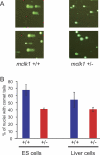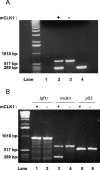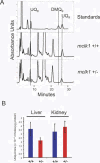Evolutionary conservation of the clk-1-dependent mechanism of longevity: loss of mclk1 increases cellular fitness and lifespan in mice
- PMID: 16195414
- PMCID: PMC1257397
- DOI: 10.1101/gad.1352905
Evolutionary conservation of the clk-1-dependent mechanism of longevity: loss of mclk1 increases cellular fitness and lifespan in mice
Abstract
Inactivation of the Caenorhabditis elegans gene clk-1, which is required for ubiquinone biosynthesis, increases lifespan by an insulin signaling-independent mechanism. We find that homozygous inactivation of mclk1, the mouse ortholog of clk-1, yields ES cells that are protected from oxidative stress and damage to DNA. Moreover, in the livers of old mclk1(+/-) mice, hepatocytes that have lost mclk1 expression by loss of heterozygosity undergo clonal expansion, suggesting that their resistance to stress allows them to outcompete cells that still express the gene. mclk1(+/-) mice, whose growth and fertility are normal, also display a substantial increase in lifespan in each of three different genetic backgrounds. These observations indicate that the distinct mechanism by which clk-1/mclk1 affects lifespan is evolutionarily conserved from nematodes to mammals and is not tied to a particular anatomy or physiology.
Figures





Similar articles
-
Genetic and molecular characterization of CLK-1/mCLK1, a conserved determinant of the rate of aging.Exp Gerontol. 2006 Oct;41(10):940-51. doi: 10.1016/j.exger.2006.06.041. Epub 2006 Aug 4. Exp Gerontol. 2006. PMID: 16889924 Review.
-
A single biochemical activity underlies the pleiotropy of the aging-related protein CLK-1.Sci Rep. 2017 Apr 12;7(1):859. doi: 10.1038/s41598-017-00754-z. Sci Rep. 2017. PMID: 28404998 Free PMC article.
-
The age of heterozygosity.Age (Dordr). 2006 Jun;28(2):201-8. doi: 10.1007/s11357-006-9006-8. Epub 2006 Jun 3. Age (Dordr). 2006. PMID: 19943141 Free PMC article.
-
Mouse CLK-1 is imported into mitochondria by an unusual process that requires a leader sequence but no membrane potential.J Biol Chem. 2001 Aug 3;276(31):29218-25. doi: 10.1074/jbc.M103686200. Epub 2001 May 31. J Biol Chem. 2001. PMID: 11387338
-
The role of ubiquinone in Caenorhabditis elegans longevity.Ageing Res Rev. 2005 Jan;4(1):41-53. doi: 10.1016/j.arr.2004.09.001. Epub 2004 Nov 28. Ageing Res Rev. 2005. PMID: 15619469 Review.
Cited by
-
Mitochondria as a target of environmental toxicants.Toxicol Sci. 2013 Jul;134(1):1-17. doi: 10.1093/toxsci/kft102. Epub 2013 Apr 29. Toxicol Sci. 2013. PMID: 23629515 Free PMC article. Review.
-
Axis of ageing: telomeres, p53 and mitochondria.Nat Rev Mol Cell Biol. 2012 May 16;13(6):397-404. doi: 10.1038/nrm3352. Nat Rev Mol Cell Biol. 2012. PMID: 22588366 Free PMC article. Review.
-
Uncoupling lifespan and healthspan in Caenorhabditis elegans longevity mutants.Proc Natl Acad Sci U S A. 2015 Jan 20;112(3):E277-86. doi: 10.1073/pnas.1412192112. Epub 2015 Jan 5. Proc Natl Acad Sci U S A. 2015. PMID: 25561524 Free PMC article.
-
Mitochondrial and cytoplasmic ROS have opposing effects on lifespan.PLoS Genet. 2015 Feb 11;11(2):e1004972. doi: 10.1371/journal.pgen.1004972. eCollection 2015 Feb. PLoS Genet. 2015. PMID: 25671321 Free PMC article.
-
Impact of Exercise and Aging on Mitochondrial Homeostasis in Skeletal Muscle: Roles of ROS and Epigenetics.Cells. 2022 Jun 30;11(13):2086. doi: 10.3390/cells11132086. Cells. 2022. PMID: 35805170 Free PMC article. Review.
References
-
- Baba T., Shimizu, T., Suzuki, Y., Ogawara, M., Isono, K., Koseki, H., Kurosawa, H., and Shirasawa, T. 2005. Estrogen, insulin, and dietary signals cooperatively regulate longevity signals to enhance resistance to oxidative stress in mice. J. Biol. Chem. 280: 16417-16426. - PubMed
-
- Benard C., McCright, B., Zhang, Y., Felkai, S., Lakowski, B., and Hekimi, S. 2001. The C. elegans maternal-effect gene clk-2 is essential for embryonic development, encodes a protein homologous to yeast Tel2p and affects telomere length. Development 128: 4045-4055. - PubMed
-
- Bluher M., Kahn, B.B., and Kahn, C.R. 2003. Extended longevity in mice lacking the insulin receptor in adipose tissue. Science 299: 572-574. - PubMed
-
- Collins A.R. 2004. The comet assay for DNA damage and repair: Principles, applications, and limitations. Mol. Biotechnol. 26: 249-261. - PubMed
-
- De Preter, K., Vandesompele, J., Heimann, P., Kockx, M.M., Van Gele, M., Hoebeeck, J., De Smet, E., Demarche, M., Laureys, G., Van Roy, N., et al. 2003. Application of laser capture microdissection in genetic analysis of neuroblastoma and neuroblastoma precursor cells. Cancer Lett. 197: 53-61. - PubMed
Publication types
MeSH terms
Substances
LinkOut - more resources
Full Text Sources
Other Literature Sources
Molecular Biology Databases
